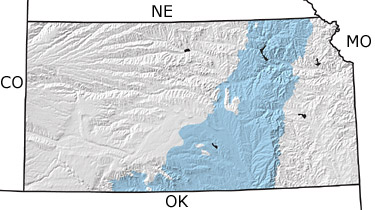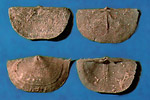Paleontology and geologyTropical sea levels rose and fell during early Permian times, as evidenced by alternating layers of mudstone and limestone. Life continued to be dominated by the typical array of invertebrates common to the late Carboniferous, such as brachiopods, echinoids, bivalves, bryozoans, crinoids, gastropods, corals, and trilobites. However, a change to a hotter and dryer climate isolated the seas to central Kansas where thick beds of salt accumulated. Later, red beds and gypsum were deposited. The harsh climate did not support a rich diversity of life, but there are rare fossils of lungfish, sharks, and other fishes. This map indicates a broad band of Permian rocks extending from the south to the north in the east-central part of the state. |


